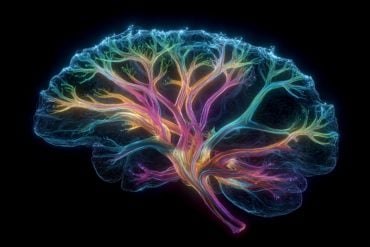Summary: New AI technology is able to detect changes to the retina and predict the risk of retinal vein occlusion. Researchers say the technology could also be used to detect heart attack and stroke risks.
Source: Monash University
New artificial intelligence (AI) technology that detects subtle changes in the retina could prove a game-changer in helping millions of people avoid vision loss or blindness.
The retinal deep learning model, developed during a three-year study by Monash University, helps GPs and health care professionals detect and predict the risk of retinal vein occlusion (RVO), which occurs when a blood clot blocks a vein in the eye’s retina.
But the technology also has the potential to predict the risk of heart attacks and stroke, because the retina is so closely connected to other parts of the body through the central nervous system.
The study, published in the journal Eye, was carried out by Monash Medical AI Group, which sits within the university’s Monash eResearch Center.
Study author Associate Professor Zongyuan Ge, also an Adjunct Senior Research Fellow in the Department of Electrical and Computer Systems Engineering, said RVO is the second most common retinal vascular disease in the world, affecting an estimated 16 million people. If diagnosed too late or left untreated, it can lead to vision loss, or in serious cases, blindness.
RVO can occur if the veins of the eyes are too narrow, and is more likely to occur in people with diabetes, high blood pressure or high cholesterol levels.
During the study, researchers trained an AI model to distinguish between more than 10,500 fundus images (photographs of the rear of the eye) collected from the West China Hospital of Sichuan University. Some of the patients captured in the photos had retinal vein occlusion, while others did not.
Associate Professor Ge said artificial intelligence has previously focused on more traditional eye diseases such as diabetic retinopathy, glaucoma or cataracts.
“However, it’s rare that a study links fundus images to neurological and systemic disease risk factors,” he said. “We believe our study enhances our understanding of what AI can really do in disease diagnosis and management.”
Hundreds of thousands of pieces of data were used to train the AI model, and enable highly accurate predictions.
“The ability of artificial intelligence to perform massive calculations and capture unknown and seemingly unrelated factors for classification is far beyond human thinking and capabilities,” Associate Professor Ge noted.
The algorithm tool will likely be a powerful tool to help doctors and clinicians predict the risk of RVO and other cardiovascular and cerebrovascular diseases such as stroke in the future—even if they don’t specialize in that area.
All they will need is a “smart” fundus camera—these are now widely available, even in developing countries—and a cloud computing platform integrated with the AI algorithm.
“We also hope the algorithm will make it much cheaper and more accessible for patients to check the health of their vessels—perhaps $20 to $40, compared to the usual cost of about $3,000 for an MRI scan in developed countries,” Associate Professor Ge said.
He said this was particularly important given Australia’s aging population, and a national shortage of ophthalmologists.
It is hoped the study will lead to clinical trials in China, Australia, the UK and the US.
About this AI and vision loss research news
Author: Press Office
Source: Monash University
Contact: Press Office – Monash University
Image: The image is in the public domain
Original Research: Closed access.
“Artificial intelligence to distinguish retinal vein occlusion patients using color fundus photographs” by Xiang Ren et al. Eye
Abstract
Artificial intelligence to distinguish retinal vein occlusion patients using color fundus photographs
Purpose
Our aim is to establish an AI model for distinguishing color fundus photographs (CFP) of RVO patients from normal individuals.
Methods
The training dataset included 2013 CFP from fellow eyes of RVO patients and 8536 age- and gender-matched normal CFP. Model performance was assessed in two independent testing datasets. We evaluated the performance of the AI model using the area under the receiver operating characteristic curve (AUC), accuracy, precision, specificity, sensitivity, and confusion matrices. We further explained the probable clinical relevance of the AI by extracting and comparing features of the retinal images.
Results
Our model achieved an average AUC was 0.9866 (95% CI: 0.9805–0.9918), accuracy was 0.9534 (95% CI: 0.9421–0.9639), precision was 0.9123 (95% CI: 0.8784–9453), specificity was 0.9810 (95% CI: 0.9729–0.9884), and sensitivity was 0.8367 (95% CI: 0.7953–0.8756) for identifying fundus images of RVO patients in training dataset. In independent external datasets 1, the AUC of the RVO group was 0.8102 (95% CI: 0.7979–0.8226), the accuracy of 0.7752 (95% CI: 0.7633–0.7875), the precision of 0.7041 (95% CI: 0.6873–0.7211), specificity of 0.6499 (95% CI: 0.6305–0.6679) and sensitivity of 0.9124 (95% CI: 0.9004–0.9241) for RVO group. There were significant differences in retinal arteriovenous ratio, optic cup to optic disc ratio, and optic disc tilt angle (p = 0.001, p = 0.0001, and p = 0.0001, respectively) between the two groups in training dataset.
Conclusion
We trained an AI model to classify color fundus photographs of RVO patients with stable performance both in internal and external datasets. This may be of great importance for risk prediction in patients with retinal venous occlusion.






